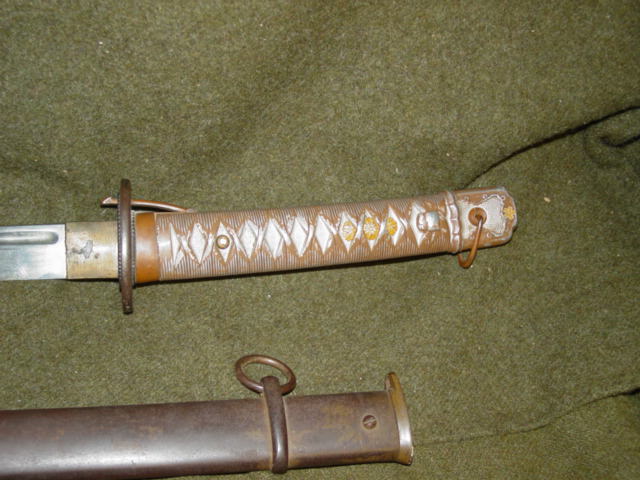|
WWII JAPANESE ARMY NCO KATANA SWORD - #19
The Samurai sword is one of the most desirable military collectibles in the market. Thanks to their use in
movies and television, the samurai sword has become a household name.
The end of WWIi marked the begining of the sword ownership ban in Japan. By law, Japanese citizens were forbiden
to own swords. General McCarthur did not want the general population to be able to arm again. Most soldiers and
citizens surrendered their swords to the American occupying forces.
The Americans destroyed a large number of swords by dumping them into the ocean or by melting them. But a percentage made its way back to the United STates and into the collector market.
The sample shown here is a WWII Japanese NCO Samurai Sword. A katana. At one point these swords were not very
desirable. The author remembers having passed the opportunity to purchase swords like these ones at swap meets
for under $100.00 because they were not very popular. However, in recent years they have gained popularity and
increased in value. This section of the website is dedicated to the discussion of the NCO type Samurai sword.

Aluminum handle construction. Wrapping and menuki are cast-formed. Typical WWII Imperial Japanese Army style fittings.
Single suspension ring from the scabbard. It is said that during battle soldiers would not use the ring but rather would
stick the sword through the belt the same way the Samurai in the old days would.
Some samples have the Menuki painted in yellow or red color.

All NCO swords were numbered. This is an example of how the number was placed in the blade. Unlike their German
counterparts, the Japanese did not keep very good account of which soldier was issued which serial numnered sword.
In some cases the serial number on the blade would match that found on the throat of the scabbard.
This is known as a "matching numbers" sword. Most swords do not have this property because somewhere along the
life of the sword the scabbrad was changed.

|
This page is a recognition and identification guide for Samurai swords.
Multiple detailed photos of a specific sample are provided. Descriptions point
out clearly defined points that should be noted.
One of the most commonly asked questions is "How much is my Samurai Sword worth?".
A price guide is included here to address this question. The value of the swords is
reviewed over a period of several years. A trend can be observed. The present worth
of the edge weapons in the collector's market is illustrated.
This service is provided free of charge to the visitor/enthusiast courtesy of
MilitaryItems.com,
a company dedicated to the preservation of military history and to providing quality
military antiques and collectibles to museums, institutions and the general public.
|
|

A side view of the handle shows the metal spring piece that secures the blade to the scabbard. This
prevents the sword from falling when the soldier is running. Traditionally this function is assigned
to the Habaki. But machine made swords like this one do not have the accuracy of manufacturing that
enable the Habaki to perform such function.

This is a WWII Japanese army NCO sword. The blades on these swords are always numbered.
They were issued to soldiers who did not want to take their family sword to battle.
This Samurai Sword may be currently reproduced.
It is becoming more difficult to be able to tell the fake ones from the real ones because
the quality of the reproductions is improving. The collector must become familiarized with
the construction style and materials employed in the manufacturing of this item.
Attention to the details is critical in order to be able to determine the authenticity of
the collectible.
If you have an interest is seeing other Japanese Samurai swords, you can do so by going to our
Japanese Samurai Swords Price Guide
identification guide. Where we cover Samurai swords from all periods.
| 




